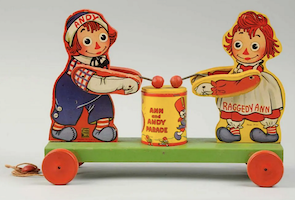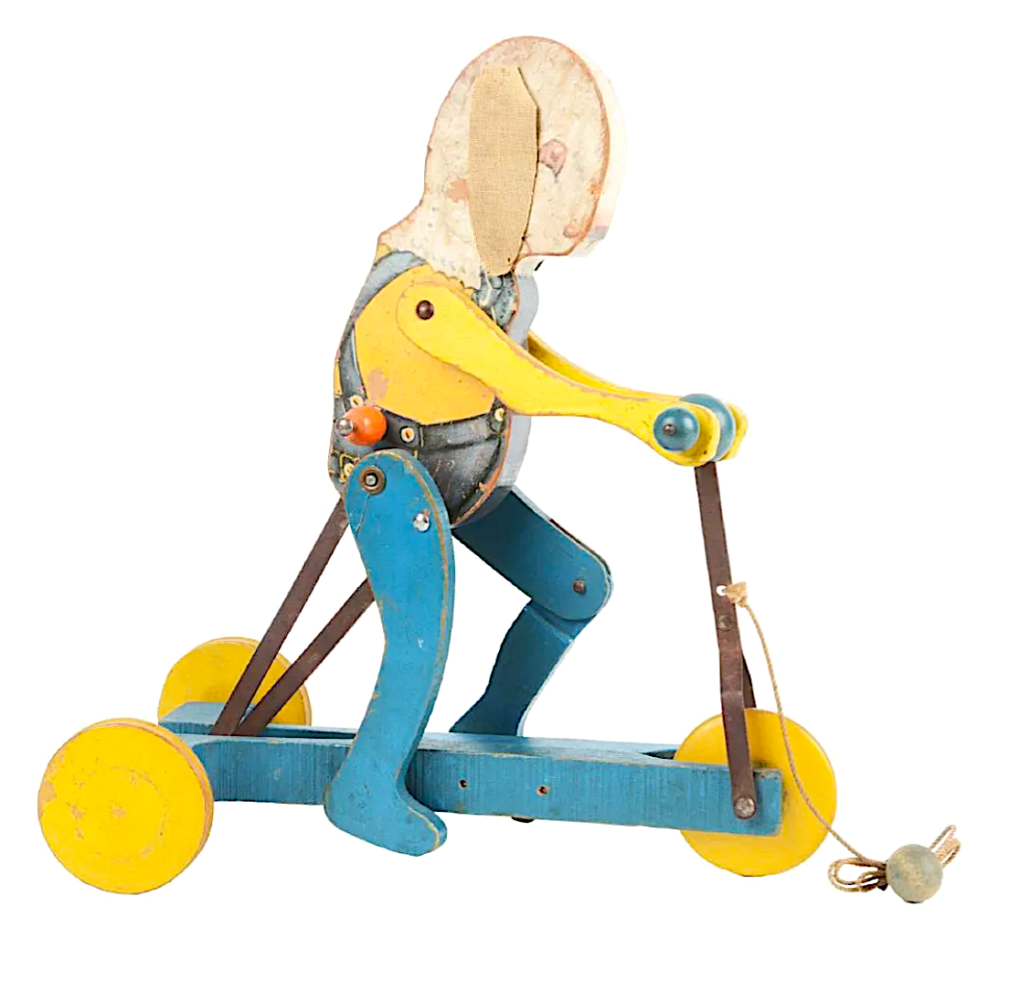LONE JACK, Mo. – Everyone loves a big multi-day antiques auction because of the sheer amount of goods from which to choose, but sometimes it’s more fun to bid at a smaller, studiously curated sale where every piece has a story to tell. That was the case at Dirk Soulis’ colorful 196-lot Mid-Americana Gallery Auction on December 10, which took in $240,000, inclusive of buyer’s premium.
Racing to the top of its category, an early 20th-century C. W. Parker iron shooting gallery target took the form of a striding whippet with a bullseye on its side. As would be expected, its patina reflected the effects of its prior use, but its paint appeared original and untouched. Signed C W Parker Abilene, Kansas on the verso, the sleek 27-inch-long hound crossed the finish line at $16,000 ($19,200 with buyer’s premium) against an estimate of $6,000-$9,000.
Also pictured in Parker’s Catalog of Shooting Galleries is an uncommon deer-form iron target. This 13in example, which trotted to $5,000 ($6,000 with buyer’s premium), was admired for its good condition and for its original brass and copper plated finish. A direct hit to the protruding heart would release the mechanism, causing the head to drop back.
Attributed to Emil Hoffman of Chicago, a ‘Pancho Villa’ cast-iron target was bid to $5,000 ($6,000 with buyer’s premium). It was probably made soon after Christmas Day, 1912 when Villa escaped from prison and fled to El Paso – his notoriety inspiring a ‘Mexican Head Target’ that appeared in the Hoffman catalog. Its eye openings are backed by a circular iron gong that rings if a shot passes through an eyehole.
A substantial ‘fishing boy’ shooting gallery target was a type never previously offered at auction. Formed from a single 3ft 10in iron casting mounted to an iron base plate, the right arm (once holding a rod or perhaps a flag) pivots with a successful shot. Formerly part of the Tucker collection, it made $5,500 ($6,600 with buyer’s premium) against an estimate of $2,000-$3,000.
A scarce 1930s sheet-iron Cowboy Gunfighter shooting gallery target drew comparisons to a larger model that was made by William F. Mangels of Coney Island, New York. While not as detailed as the similar target produced by Mangels, the cowboy auctioned by Soulis was a nice buy at $6,500 ($7,800 with buyer’s premium), roughly the midpoint of its estimate range.
Figural weathervanes that adorned the rooftops of 19th-century rural barns and houses are staples in Americana collections, so the opportunity to acquire a rare form at the sale was appealing to many bidders. The auction’s top lot, ambling its way to $19,000 ($22,300 with buyer’s premium), was a three-dimensional vane in the shape of a dairy cow. Attributed to the Boston firm A. J. Harris & Co. (active 1868-1882), it was modeled in fine detail and proportionate to a real-life cow. Its copper body exhibited an attractive time-generated layer of verdigris, with a powdery, granular oxidation present on the iron head. “Weathervanes like this, with a heavier, more solid head, would balance a vane properly and be more likely to keep the figure facing into the wind,” said Dirk Soulis, owner of Soulis Auctions.
Also selling well was an important mid-19th-century carved and painted pine whirligig of a gentleman in a top hat and jacket with tails worn over a mustard-colored waistcoat and brownish-red trousers. Well known to the collecting community, it has been attributed by some as the circa-1860 work of a Bucks County, Pennsylvania carver named Amos Schultz. Against an estimate of $3,000-$4,000, it left the building with an Iowa collector who paid $18,000 ($22,140 with buyer’s premium).
Another standout in the folk art category was a pull toy depicting an animated top-hatted man on an articulated horse with an articulated dog running alongside them. A book example, the toy had previously been exhibited at several prestigious institutions, including the Museum of American Folk Art, the Brooklyn Museum, and the New York Historical Society. It sold to a prominent New England dealer for $6,500 ($7,995 with buyer’s premium) against an estimate of $2,000-$4,000.

C. W. Parker whippet iron shooting gallery target, which sold for $16,000 ($19,200 with buyer’s premium) at Soulis Auctions.

C.W. Parker brass-plated cast-iron deer target, which sold for $5,000 ($6,000 with buyer’s premium) at Soulis Auctions.

Early 20th-century ‘Pancho Villa’ cast-iron target attributed to Emil Hoffman of Chicago, which sold for $5,000 ($6,000 with buyer’s premium) at Soulis Auctions.

Heavy iron fishing boy shooting gallery target, which sold for $5,500 ($6,600 with buyer’s premium) at Soulis Auctions.




